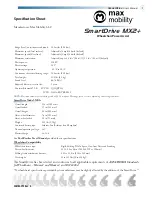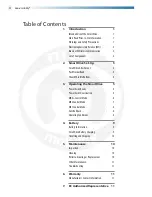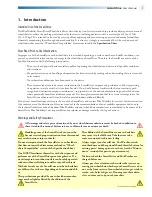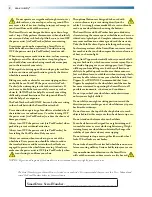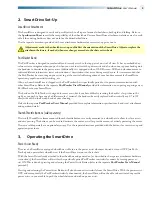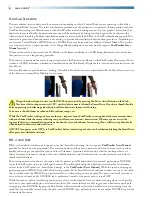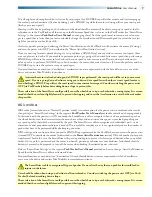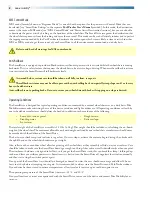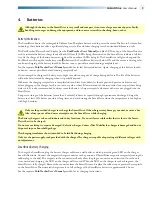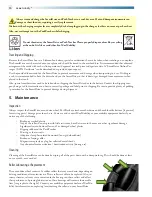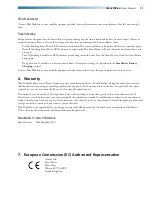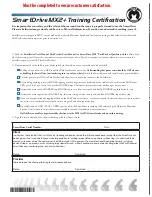
SmartDrive
User’s Manual
3
Electromagnetic Interference (EMI)
Electromagnetic Interference comes from radio wave sources. Examples of these sources are radio / TV station transmit-
ters, receivers, transceivers [send and receive signals], cell phones, walkie-talkies, etc. There are many sources of EMI in one’s
daily environment, some that are avoidable and some that one might not even realize. Powered electronic devices, such as
the SmartDrive are susceptible to EMI, both strong and weak, from these types of transmitters, as well as from electrostatic
discharges (ESD) and conducted sources. These interferences can cause unintentional activation of the SmartDrive motor or
damage to its control system, potentially causing a safety hazard and leading to costly repairs.
Every power wheelchair or power assist device can resist EMI up to a certain level, also known as its “immunity level”. The
higher the immunity level, the less the device is at risk of interference. An immunity level of 20 V/m is understood to provide
sufficient protection from the sources encountered on a daily basis. The SmartDrive has been tested and found to be immune
to this minimum immunity level of 20 V/m. Though equipped to be sufficiently protected against EMI, any chair modifica-
tions or accessory additions can effect its immunity. Parts from other suppliers have unknown EMI properties, and their inter-
action with the SmartDrive is untested.
Electromagnetic energy becomes increasing more intense the closer to the source you become. Therefore, it is recommended
that the SmartDrive not be operated in close vicinity to sources of radio waves. There are three categories that EMI sources
fall under:
1.
Long Range Transceivers: These are sources of strong radio waves, including commercial radio and TV broadcast
antenna towers and amateur (HAM) radios.
2.
Medium Range Mobile Transceivers: These are sources of potentially strong radio waves, including two-way radios
used by emergency vehicles, tractor-trailers, and taxis.
3.
Handheld Transceivers: These are sources of relatively low strength waves but have the possibility of getting very
close to your wheelchair, including walkie-talkies, citizen band (CB) radios, cell phones, and other personal com-
munication devices.
The following are not likely to cause EMI problems: Cordless phones, MP3 / CD players, TV sets, and AM / FM radios.
USA / Canada
This device complies with Part 15 of the FCC rules. Operation is subject to the following two conditions: (1) This device may
not cause harmful interference, and (2) this device must accept any interference, including interference that may cause unde-
sired operation. Any changes or modifications not expressly approved by the party responsible for compliance could void the
user’s authority to operate the equipment.
Bluetooth® Wireless Communication
Bluetooth® wireless communication [2.4 GHz frequency band] is used by the PushTracker to communicate to the Smart-
Drive when to activate / deactivate the power assist, send and receive signals from a smartphone, etc. The PushTracker must
be within 25 ft (8 meters) of the SmartDrive / smartphone to connect and communicate. The maximum output power of this
technology is 10 mW, and the operation of this device in close proximity to other wireless devices [i.e. electromagnetic secu-
rity systems, Bluetooth® headsets, etc.] could cause the device to lose connection. Power assist is always deactivated whenever
the motor is driving and there is a loss of connection; the SmartDrive will beep and PushTracker will also give indication
when this happens. Worst case coexistence testing was performed on the device to ensure its safety and effectiveness. Please
contact Max Mobility immediately for troubleshooting if continuous connection issues are experienced with the device.
Do not operate hand-held transceivers (transmitters-receivers), such as citizens band (CB) radios, or turn on
personal communication devices, such as cellular phones, while the power assist is ON.
Be aware of nearby transmitters, such as radio or TV stations, and try to avoid coming close to them.
If unintended movement occurs, turn the power assist OFF as soon as it is safe.
Be aware that adding accessories or components to your wheelchair may make it more susceptible to EMI [Note: There is
not easy way to evaluate their effect on the overall immunity of the device].
Report all incidents of unintended movement to Max Mobility, and note whether there is a source of EMI nearby.


